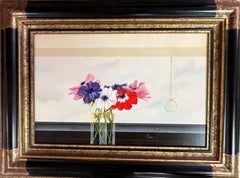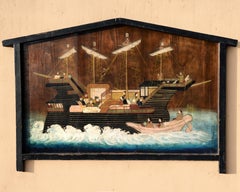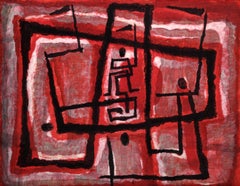Sabine Satur Art
French, b. 1954
Sabine Satur was born in France in 1954. She studied at École Supérieure des Beaux-Arts, Seville from 1970–75, and École Supérieure des Beaux-Arts, Rouen from 1976–77. Satur has exhibited throughout Europe and the United States. She has also been awarded the Medaille d'Argent, Salon des Artistes Français, Paris.
to
2
2
2
2
Overall Height
to
Overall Width
to
2
1
1
1
1
1
1
2
1
2
6,886
3,210
2,514
1,217
2
2
2
2
Artist: Sabine Satur
Bouquet on table
By Sabine Satur
Located in New York, NY
About the Item
We purchased a large amount paintings by this artist and A. Matallana the spouse and other images upon request.
Category
1990s Impressionist Sabine Satur Art
Materials
Oil, Egg Tempera
Champagne glass
By Sabine Satur
Located in New York, NY
We purchased a large amount paintings by this artist and A. Matallana the spouse and other images upon request.
Category
20th Century Impressionist Sabine Satur Art
Materials
Oil, Egg Tempera
Related Items
Large Japanese Wood Board Ema Namban Depicting a Portuguese Ship Edo period
Located in Stockholm, SE
An Ema is a votive plaque people hang in a "dedication area", at a Shinto shrine, with their wish to the gods. Wishes usually would revolve around health, love, career, prosperity, a...
Category
Mid-19th Century Realist Sabine Satur Art
Materials
Wood, Tempera, Egg Tempera, Wood Panel
Margaret Balzer, 1946
Located in Washington, DC
Modern painting by Margaret Balzer Cantieni (1914-2002). Tempera on wood board. Signed in lower right corner "Balzer '46". Painting measures 1 1" x 14" with frame 16 1/2" x 19 1/2".
Margaret Balzer studied at the Art Institute of Chicago with Lyonel Feininger, Josef Albers and William Stanley Hayter...
Category
1940s Abstract Sabine Satur Art
Materials
Board, Egg Tempera
Japan. Hokkaido Island at sunrise. Modern Impasto fine art. Impressionism style.
Located in Sempach, LU
Less populated than any other part of the country, Japan's northernmost island, Hokkaido, is every nature lover's dream. Its wild and untouched landscapes are home to six incredible national parks.
Thus, the huge island has a rich wildlife that you can enjoy like nowhere else in Japan.
This original beautiful painting was created on a high-quality canvas (80/60 cm) with a palette knife, using Tempera and environmentally friendly oil colors with natural pigment. The painting was created in a unique individual technique in the impressionism style. The impasto painting style, achieved with a palette knife, gives the piece incredible depth and texture, creating a feeling of complete contact with nature. It does not require a frame. Painting is covered with UV varnish. Signed back. Ready to hang.
Сontemporary Art. One-of-a-Kind Painting (only one piece worldwide). Certificate is attached.
This artwork is from a series of paintings that heal your space.
About the artist:
Vik Schroeder...
Category
2010s Impressionist Sabine Satur Art
Materials
Tempera, Oil
Vik Schroeder Japan. Hokkaido Island at sunrise. Modern Impasto fine art. Impressionism style., 2023
H 31.5 in W 23.63 in D 0.79 in
La Grande Parisienne. Contemporary Figurative Oil Painting
By Sax Berlin
Located in Brecon, Powys
When this beautiful piece was created Berlin had been staging a one man renaissance of the early 20th Century School of Paris. For 8 years in this wing of study he used the shapes of...
Category
2010s Contemporary Sabine Satur Art
Materials
Marble
Pikes Peak, 1940s Colorado Mountain Landscape in Autumn, Tempera Painting
By Charles Ragland Bunnell
Located in Denver, CO
Original vintage 1941 Colorado landscape painting with autumn leaves and Pikes Peak blanketed in snow by Charles Bunnell (1897-1968). Inscribed verso, "To Laura, November 22, 1941", egg tempera on board. Signed by the artist in the lower left corner and titled verso. Presented in a custom frame, outer dimensions measure 15 ½ x 19 ¼ x 1 ¼ inches. Image size is 7 ¾ x 11 inches
About the Artist:
Artist and teacher, Charles ("Charlie") Bunnell worked in a variety of styles throughout his career because as an artist he believed, "I’ve got to paint a thousand different ways. I don’t paint any one way." At different times he did representational landscapes while concurrently involved with semi- or completely abstract imagery. He was one of a relatively small number of artists in Colorado successfully incorporating into their work the new trends emanating from New York and Europe after World War II. During his lifetime he generally did not attract a great deal of critical attention from museums, critics and academia. However, he personally experienced a highpoint in his career when Katherine Kuh, curator at the Art Institute of Chicago, personally chose one of his paintings - Why? - for its large exhibition of several hundred examples of abstract and surrealist art held in 1947-48, subsequently including it among the fifty pieces selected for a traveling show to ten other American museums.
An only child, Bunnell developed his love of art at a young age through frequent drawing and political cartooning. In high school he was interested in baseball and golf and also was the tennis champion for Westport High School in Kansas City. Following graduation, his father moved the family to Denver, Colorado, in 1916 for a better-paying bookkeeping job, before relocating the following year to Colorado Springs to work for local businessman, Edmond C. van Diest, President of the Western Public Service Company and the Colorado Concrete Company. Bunnell would spend almost all of his adult life in Colorado Springs.
In 1918 he enlisted in the United States Army, serving in the 62nd Infantry Regiment through the end of World War I. Returning home with a 10% disability, he joined the Zebulon Pike Post No. 1 of the Disabled American Veterans Association and in 1921 used the benefits from his disability to attend a class in commercial art design conducted under a government program in Colorado Springs. The following year he transferred to the Broadmoor Art Academy (founded in 1919) where he studied with William Potter and in 1923 with Birger Sandzén. Sandzén’s influence is reflected in Bunnell’s untitled Colorado landscape (1925) with a bright blue-rose palette.
For several years thereafter Bunnell worked independently until returning to the Broadmoor Art Academy to study in 1927-28 with Ernest Lawson, who previously taught at the Kansas City Art Institute where Bunnell himself later taught in the summers of 1929-1930 and in 1940-41. Lawson, a landscapist and colorist, was known for his early twentieth-century connection with "The Eight" in New York, a group of forward-looking painters including Robert Henri and John Sloan whose subject matter combined a modernist style with urban-based realism. Bunnell, who won first-place awards in Lawson’s landscapes classes at the Academy, was promoted to his assistant instructor for the figure classes in the 1928-29 winter term. Lawson, who painted in what New York critic James Huneker termed a "crushed jewel" technique, enjoyed additional recognition as a member of the Committee on Foreign Exhibits that helped organize the landmark New York Armory Exhibition in 1913 in which Lawson showed and which introduced European avant-garde art to the American public.
As noted in his 1964 interview for the Archives of American Art in Washington, DC, Bunnell learned the most about his teacher’s use of color by talking with him about it over Scotch as his assistant instructor. "Believe me," Bunnell later said, "[Ernie] knew color, one of the few Americans that did." His association with Lawson resulted in local scenes of Pikes Peak, Eleven Mile Canyon, the Gold Cycle Mine near Colorado City and other similar sites, employing built up pigments that allowed the surfaces of his canvases to shimmer with color and light. (Eleven Mile Canyon was shown in the annual juried show at the Carnegie Institute in Pittsburgh in 1928, an early recognition of his talent outside of Colorado.) At the same time, he animated his scenes of Colorado Springs locales by defining the image shapes with color and line as demonstrated in Contrasts (1929). Included in the Midwestern Artists’ Exhibition in Kansas City in 1929, it earned him the gold medal of the Kansas City Art Institute, auguring his career as a professional artist.
In the 1930s Bunnell used the oil, watercolor and lithography media to create a mini-genre of Colorado’s old mining towns and mills, subject matter spurned by many local artists at the time in favor of grand mountain scenery. In contrast to his earlier images, these newer ones - both daytime and nocturnal -- such as Blue Bird Mine essentially are form studies. The conical, square and rectangular shapes of the buildings and other structures are placed in the stark, undulating terrain of the mountains and valleys devoid of any vegetation or human presence. In the mid-1930s he also used the same approach in his monochromatic lithographs titled Evolution, Late Evening, K.C. (Kansas City) and The Mill, continuing it into the next decade with his oil painting, Pikes Peak (1942).
During the early 1930s he studied for a time with Boardman Robinson, director of the Broadmoor Art Academy and its successor institution, the Colorado Springs Fine Arts Center from 1930 to 1947. In 1934 Robinson gave him the mural commission under the Public Works of Art Project (PWAP) for West Junior High School in Colorado Springs, his first involvement in one of several New Deal art...
Category
1930s American Impressionist Sabine Satur Art
Materials
Egg Tempera, Board
H 15.5 in W 19.25 in D 1.25 in
New Orleans Sounds Egg Tempera 9 x 12 Portraiture Finalist PSA Jazz Music
By E. Melinda Morrison
Located in Houston, TX
While walking in Jackson Square in New Orleans, you can't help but hear the trumpets and trombones of the Jackson Street band that spends their time entertaining the tourists and loc...
Category
2010s American Impressionist Sabine Satur Art
Materials
Panel, Egg Tempera
White Dawn
By John Little
Located in Austin, TX
Egg emulsion on fiberglass. Signed and dated upper left and verso; titled verso.
49 x 48 in.
49.75 x 49 in. (framed)
Custom framed in hickory.
Provenance
Albright-Knox Art Gallery, Buffalo, NY
Born in Alabama, John Little attended the Buffalo (NY) Fine Arts Academy as a teenager, until 1927. Soon after, he moved to New York where he began operatic vocal training and opened what would become a very successful textile business designing fabric and wallpaper.
In 1933, he enrolled at the Art Students League under the tutelage of George Grosz. Little’s early work consisted predominantly of landscapes, until 1937, when he began studying under Hans Hofmann and his work naturally shifted toward abstraction. During his time with Hofmann, he with artists such as Lee Krasner, George McNeil, Gerome Kamrowski, Giorgio Cavallon...
Category
1960s Abstract Expressionist Sabine Satur Art
Materials
Fiberglass, Egg Tempera
Painter's Palette
By Miles Cleveland Goodwin
Located in Dallas, TX
After a tour of duty in the US Navy, Miles Cleveland Goodwin earned a BFA from Pacific Northwest College of Art in Portland, Oregon, in 2007, and eventually returned to coastal Missi...
Category
2010s Contemporary Sabine Satur Art
Materials
Egg Tempera, Oil, Panel
Girl from a Distant Future
By Barnaby Fitzgerald
Located in Dallas, TX
This is egg-oil on Birch panel.
A professor of painting at Southern Methodist University since 1984, Barnaby Fitzgerald spent his childhood in Italy where he earned a printmaking de...
Category
2010s Contemporary Sabine Satur Art
Materials
Birch, Oil, Egg Tempera
The Vegetable Seller, Mauritius
By Stuart Maxwell Armfield
Located in London, GB
Tempera on board, 87cm x 60cm (framed 106cm x 78cm).
Stuart Maxwell Armfield (1916-2000) was renowned for his use of the traditional egg tempera technique, a skilled process that us...
Category
1940s Post-War Sabine Satur Art
Materials
Egg Tempera, Board
Flying in Dreams
Located in Naples, FL
Characterized by his deeply honest means of expression and fascination with Orientalism, Surrealism, and social commentary, Moscow painter Stanislav Plutenko...
Category
2010s Surrealist Sabine Satur Art
Materials
Oil, Egg Tempera
The Race
Located in Naples, FL
Characterized by his deeply honest means of expression and fascination with Orientalism, Surrealism, and social commentary, Moscow painter Stanislav Plutenko...
Category
2010s Surrealist Sabine Satur Art
Materials
Oil, Egg Tempera
Sabine Satur art for sale on 1stDibs.
Find a wide variety of authentic Sabine Satur art available for sale on 1stDibs. You can also browse by medium to find art by Sabine Satur in egg tempera, oil paint, paint and more. Much of the original work by this artist or collective was created during the 20th century and is mostly associated with the Impressionist style. Not every interior allows for large Sabine Satur art, so small editions measuring 19 inches across are available. Customers who are interested in this artist might also find the work of Yolande Ardissone, Marie Duhem, and Emil Kosa Jr.. Sabine Satur art prices can differ depending upon medium, time period and other attributes. On 1stDibs, the price for these items starts at $5,500 and tops out at $5,500, while the average work can sell for $5,500.



